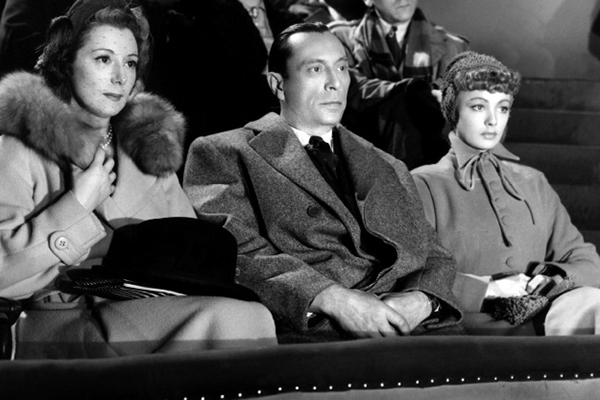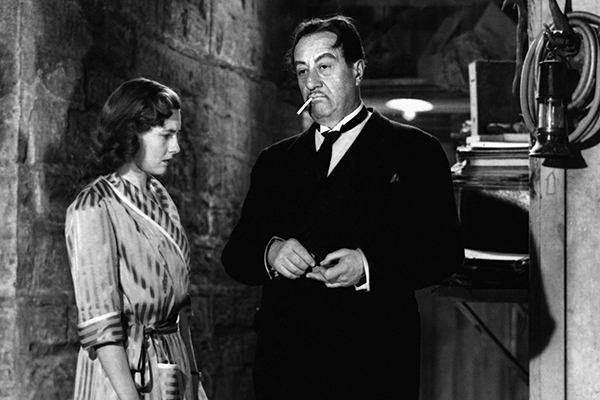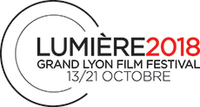Two grand artisans of cinema
#Lumière2018
by Serge Kaganski
Posted on october 15, 2018
By scheduling tributes to Richard Thorpe and Henri Decoin, the Lumière festival has demonstrated a certain coherence…
Beyond their differences of nationality and style, some common points unite the American and the Frenchman. Both are relatively unknown, their names shine a bit dimmer than their contemporaries, glorified by cinephile history (Ford, Hawks, Hitchcock, Minelli in Hollywood; Renoir, Carné, Grémillon, Duvivier in France); they have both worked in multiple genres (adventure, comedy, musical comedy, film noir...) and their lack of recognition is inversely proportional to the size of their body of work (50 for Decoin, 100 for Thorpe!), spanning three or four decades.
Long before becoming familiar with his name, for me, Richard Thorpe was synonymous with Sunday afternoon TV movies of my childhood, dubbed in French, well before I’d discovered “La Dernière Séance” (“The Last Show”), hosted by our friend Eddy. At the time, I would not have seen the difference between “The Prisoner of Zenda” and “Fanfan la Tulipe,” as long as I got to see an epic duel with swords that could keep me on the edge of my couch. It was a time when only the choreography of cloak and sword counted, no matter the director, the nationality of the film or the fact it was dubbed. Later, my teenage and adult film buff passion developed, and if I did learn the name of Richard Thorpe, it remained poorly stored in my hard drive. For me, he was the director of “The Prisoner of Zenda,” “Ivanhoe” and “Jailhouse Rock,” but I was unaware of 95% of his filmography.
This afternoon I saw “The Prisoner of Zenda” again, and what struck me, besides the great duel scene, the wondrous movements, gestures and retreats to all the recesses of the set, was the proximity of this film to the world of Hergé. I do not know if Thorpe or the bosses at MGM knew the work of the mythical Belgian (probably not) but Zenda strangely resembles an adaptation of ‘King Ottokar's Sceptre’ (the same realm of fictional operetta, same style of costumes, same kind of plot-based theme of overthrowing the monarchy, even its clear linear style - the thin and graphic face of Stewart Granger could have been sketched by Hergé's pencils).
There is also a lightness, an innocence, a playfulness of the film that seems to have disappeared today and which probably corresponded to the time and place where it was made. We feel that Thorpe is unpretentious, does not claim to be a grand “Auteur” of cinema, but accomplishes his job simply and wonderfully, as a salaried director of a dream factory, just as a good baker makes good bread every day. But observe the quality of the special effects that sometimes make two Stewart Grangers appear (as the king and his twin cousin) in the same shot; it was filmed in 1952, when green screens and digital film did not exist, and yet the illusion is perfect, seamless and flawless. I look forward to seeing more Thorpe movies in the coming week
Henri Decoin, is similar; I know him even less than Thorpe, often confusing him with his son, Didier Decoin, writer and president of the Goncourt jury, so I have much to discover. I learn that before becoming prolific filmmaker, he was a WWI hero, then a swim champ! A genius of an era when sport and art could get along famously. Imagine today, Alain Bernard or Florent Manaudou turning into a Jacques Audiard or François Ozon? It’s unlikely... Well, on the other hand, Eric Cantona has become both an actor and a painter, so there are always exceptions that confirm the rule.
Today, I took in two Decoins. Double Decoins (ndlt “coin” means “corner” in French) do not make four corners, but two wonders. Directed in 1947 right after the war, “Monelle” (“Les Amoureux sont seuls au monde”) impressed on all levels by the brilliant dialogues of Henri Jeanson ("Love at first sight has fallen by the wayside," "I do not trust your silence"...) and the caliber of actors (Renée Devillers, all intelligence and class, Dany Robin, the sexy ingénue and Louis Jouvet... um, should we say it? Louis Jouvet, capital L, capital J). Particularly remarkable was the finesse and modernity of this reflection on relationships, everlasting love, infidelity... and the harm tabloids can inflict.
The opening scene itself is great: Jouvet flirts with Devillers in a country inn, explaining that they must act like actors in the movies, that it is useless to resist, since the audience knows that the pair will fall in love, becaise they are played by the two stars… Then we find out that this couple has been married for twenty years and were only replaying the scene of how they met. And throughout the film, the couple continues to comment on their relationship, analyzing what binds them, or could break them up. In 1947, Decoin thus had already made “metacinema,” playing with the moviegoers’ beliefs, overturning the usual rules of fiction by revealing the usually-hidden seams and the undersides of tricks of the trade.
L “Strangers in the House” (“Les Inconnus dans la maison”) was filmed during an obscure period, in 1942, produced by the Continental (the French production firm controlled by the Nazis). It is a bleak film, containing some comic elements. A crime is committed in a provincial town and suspicions quickly point to a local youth gang. The atmosphere seems cursed and dark, a reminder of daily life in occupied France. Raimu embodies a solitary lawyer who is lonely, depressed and alcoholic, but who will regain his lease on life by defending one of the youngsters charged. We cannot find adequate words for Raimu any more than we can for Jouvet. Huge? Immense? Colossal? An uber-genius? All these epithets poorly reflect what the actor accomplishes in his performance of infinite variety that goes from the subtle (everything said in a glance, without a word, through a minute shift in expression...) to the thundering (the monumental final court scene). All of it to deliver a scathing criticism of bourgeois morality and social appearances; an urgent and passionate plea for the freedom of youth.
As a bonus, the film was brilliantly presented by Vincent Lindon and Didier Decoin, the former insisting on the humble grandeur of the filmmaker and on Raimu’s performance, the latter recounting in detail the circumstances behind the film. I await the continuation, thinking to myself, "I can’t wait to see another Decoin!"




